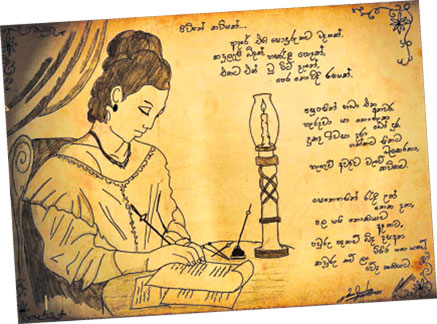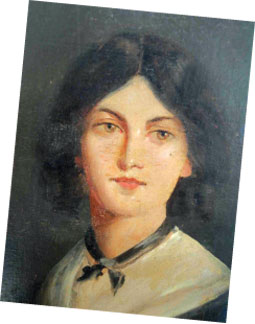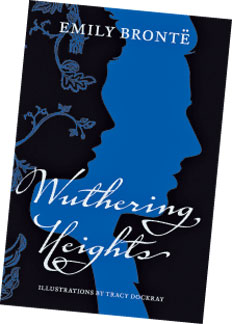Gajaman Nona and Emily Bronté
By Shireen SENADHIRA
Punchi ruwan, punchi ruwan, punchi kalé
watura aran linda uda tabuwaya kalé
ata paha nodanna jadayek meka kalé
gedara yanna denawada magé punchi kalé
 |
|
Gajaman Nona |
A little golden coloured pot filled with water was placed on the
ledge of the well. A scoundrel who doesn’t even know five from eight has
hidden the pot. Give me the pot to go home. <P>This was the poem uttered
by an angry 8-year-old girl who had gone to fetch water and found that
her pot of water was hidden impeding her going home. Her quick impromptu
repartee chided the prankster. The little girl was none other than
Gajaman Nona. When her father heard what happened at the well he smiled.
He was pleased as his daughter had displayed her prowess in poetry which
was a characteristic of his lineage.
Growing up
Gajaman Nona of Sri Lanka (1748-1814) lived in the end of Dutch and
early British rule of the country in the south of Sri Lanka. She was
able to spew out poetry as answer to any question, anytime. She had an
erudite mind and was keen to learn. Teaching, at that time was only in
Buddhist temples by Buddhist monks and no female students were allowed.
Education was only for males and girls were expected to stay at home to
manage a household, learn to be efficient in making good homes and to be
housewives. The desire to learn was inherent in Gajaman Nona and the
rules of the times could not keep her from getting educated. Disguised
as a boy, she enrolled herself as a student in the temple school. She
was strong even at that age to go against the norm.
Emily Jane Bronté (1818 – 1848) was born after the demise of Gajaman
Nona far away in Britain and lived in a remote area in the North of
England in a place called Haworth in Yorkshire where her father was the
Anglican parson. Emily’s mother died when she was very young and she had
two sisters and a brother and they lived in Haworth’s parsonage. Emily
became a well known writer and author.
In the parsonage they lived, the Bronté children were taught by their
father in their young days. The father was liberal minded and every day
he, himself, or their aunt who minded them or an older child read out
from the daily newspapers to the children. In this way the children even
at a young age were well versed in politics. There were many high
quality magazines too that arrived at the parsonage.
These and the classics added to the children’s information and
knowledge. The garden of the parsonage and church looked out into the
wild moors of Yorkshire and it was the children’s delight to walk the
moors. They even took their reclusive father in their walks and included
him in some of their games. Thus, they did find plenty to interest them.
As children, the young Brontés had one another and books as their
companions. In their isolation, they created a fantasy island kingdom
called Angria and wrote notebooks describing its turbulent history. When
their brother received twelve wooden soldiers as a gift from father, the
soldiers became characters in their imaginary world. One was Duke of
Wellington, (Wellington was then the current Prime Minister of the
United Kingdom,) and another was Napoleon Bonaparte.
 As Emily and her younger sister were often relegated to inferior
positions in the game, they staged a rebellion and established an
imaginary world of Gondal for themselves. Their stories pertaining to
Gondal , an island in the South Pacific, were full of melodrama and
intrigue, with history of wars and kings. Unfortunately, the stories of
Gondal were lost but the through their diary entries and poems they
wrote to each other, the outlines of the stories were constructed. These
were not a few stories but sagas that all the Bronté children wrote. As Emily and her younger sister were often relegated to inferior
positions in the game, they staged a rebellion and established an
imaginary world of Gondal for themselves. Their stories pertaining to
Gondal , an island in the South Pacific, were full of melodrama and
intrigue, with history of wars and kings. Unfortunately, the stories of
Gondal were lost but the through their diary entries and poems they
wrote to each other, the outlines of the stories were constructed. These
were not a few stories but sagas that all the Bronté children wrote.
In earlier times Emily was working out her place in the world and it
is reflected in the poem “true to myself and true to all, may I be
healthful still and turn away from passions call and curb my own free
will.” In a late Gondal poem Emily’s assessment of society and the world
was adamant. “Twas grief enough to think mankind, all hollow, servile,
insincere; But worse to trust to my own mind and find the same
corruption there.”
Romanticism
Though, in time, the life span of Gajaman Nona preceded that of Emily
Bronté, they were like two peas. Emily and Gajaman came from different
parts of the world, one from Europe and the other from Asia with very
different climates, cultures and languages but the two displayed similar
traits.
With poetry pouring out of their mouths and writing about nature or
any subject that caught their fancy, they were examples of the romantics
in literature. Actually, Romanticism, an artistic, literary and
intellectual movement did originate in Europe, had its peak roughly from
1800-1840.
This movement began partly due to the Industrial revolution of Europe
and more, a revolt against the aristocratic social and political norms
as well as a reaction against the scientific realization of nature. It
was embodied most strongly in the visual arts, music and literature. The
movement emphasized strong emotion as an authentic source of aesthetic
experience and awe, especially that which is experienced in confronting
untamed nature and its picturesque qualities.
Gajaman Nona’s poetic expression on the Nuga (Banyan) tree of
Denipitiya is very well known. It is a powerful outburst of hers on the
aesthetic beauty of massive tree in scenic Denipitiya in contrast to its
surroundings. The alliterative metre is well seen in this poem of hers
as well as the abundance of her ideas and language, displaying her
creativity.
Other poetry is what she sang in praise of Mudliars and other
important people who patronized her. On her father’s demise she wrote a
sorrowful ballad of many verses. Her poetic appeal to John D’Oyly, the
Government Agent of her area manifested her inborn flair for poetry
polished by learning and experience. This won her a nindagam land which
she used for living and farming.
Nature
Many poets at that time preferred to exchange ideas in verse with her
and she replied to every poet in verse, Emily Bronté in her short life
left behind a number of poems that described mostly nature and one
novel. This book is one the greatest books ever written. Wuthering
Heights, her novel is surely the most profoundly violent love story ever
written and so beautifully too.
Despite her good looks, Emily appears to have had no experience of
love but she seems to have had an anguished knowledge of passion. She
had the knowledge which links love not only with clarity but also with
violence and death. Perhaps, living in the bleak areas of Yorkshire she
had seen and realized the harshness of life.
 Emily’s poem “Love is like the wild rose briar,” continues as,
“Friendship, like the holly tree. The holly is dark when the rose briar
blooms, but which will bloom most constantly.” This rhyming verse poem
has three stanzas, each with four lines of equal length. The poem is
Emily’s unique approach to comparing love and friendship. It is
extremely effective in communicating her message and the style in which
it is written makes it interesting to read. Emily’s poem “Love is like the wild rose briar,” continues as,
“Friendship, like the holly tree. The holly is dark when the rose briar
blooms, but which will bloom most constantly.” This rhyming verse poem
has three stanzas, each with four lines of equal length. The poem is
Emily’s unique approach to comparing love and friendship. It is
extremely effective in communicating her message and the style in which
it is written makes it interesting to read.
To a posthumous 1850 anthology of Emily’s poems an undated poem was
added. This poem had a couple of verses and the last was: “I’ll walk
where my own nature would be leading; it vexes me to choose another
guide; where the grey flocks in ferny glens are feeding; where the wild
wind blows on the mountain side.”
Rebellious nature
The society at that time failed lamentably in understanding Gajaman
Nona, such an erudite woman. It was society that made Gajaman into a
kind of rebel even when young as nothing stopped her getting the
education she wanted. Later, Gajaman was left with four children out of
two marriages with two husbands dead.
When her father too died she had to fend for herself. She did acquire
a tough resistance, one that could easily distance trouble makers
invading her privacy. For this purpose she sensibly used satirically
violent and sharp verses in direct response to people’s off-colour
remarks.
Unlike the typical Sinhala woman who was largely limited in her
freedom to behave freely in society, Gajaman dressed herself like a
Dutch lady, joked and spoke with every type of person and used to go
alone wherever she wanted. Her close association with the Dutch society
in Colombo during her childhood made her unblushing before men and her
attitudes and thinking contrasted noticeably from contemporary women.
Emily Bronté, the author of Wuthering Heights present women that
rebel against constraining and oppressive social norms attempting to
free their passionate natures from the many limiting forms of the yokes
and moulds of convention. Rebellion pervades Wuthering Heights. Its key
note is passion and this made female imagination free from the previous
social and literary conventions of the monotony of the domestic sphere.
In the novel, the characters, Cathy and Hareton’s revolt against
Heathcliff, mirrors Caherine and Heathcliff’s revolt against Hindley.
Emily uses this to emphasise that Catherine ought to have rebelled and
married Heathcliff. This is the crux of the novel, favouring passion
over convention.
Catherine Earnshaw prefers to explore the moors with Heathcliff
instead of making puddings and sewing. This demonstrates a passion and a
restlessness that cannot be compressed into the conventional female
sphere. Her wanting to marry Edgar Linton, to be the grand woman of the
neighbourhood would traditionally be commended by the Victorian society
but Emily portrays it as having disastrous consequences.
The readers of Wuthering Heights could hardly comprehend the love of
Catherine and Heathcliff but no reader ever forgets it. Emily Bronté
created a dynamic and passionate alternative to the dreary domestic
monotony that faced many Victorian women and gave way to free thinking
about relationships between love and social convention.
This passion has remained with the readers since the novel was
published, and has left hearts and minds, as well as the wild moors,
haunted by the restless ghosts of Catherine and Heathcliff.
Economic hardships
Both Gajaman Nona and Emily Bronté, underwent economic hardships. The
former had to battle with all kinds of domestic adversity and only her
razor-sharp intelligence opened a way to improve her life prospects.
Though she was without substantial property left by her two dead
husbands, she invariably found a way to sustain her four children.
She earned a scanty income teaching the children of higher class
families and by eulogizing important personnel. Her father’s death
plunged her into deeper misery and it was only her poetic flair that
made it possible for her to tide over bad economic times.
For Emily too, there was no regular income. They had managed all
their lives on a poor clergyman’s wage. Some days the meat on their
dining table was a gift from one the parishioners. Emily and her older
sister Charlotte were teachers for a time.
It was the youngest sister who was a governess and kept her job for a
long time. When Aunt Branwell , who minded them when little and kept
house for the family, died, she left a legacy for the all the children
and they managed well for some time.
If both these clever women lived 150 years later how well they could
have managed their finances and their lives. They could have had their
own school or they could have written poetry and novels and collected
their money. Imagine what they would have done with a crowd like that
would come to an open air pop concert?
Would Gajaman have thrived and held sway spouting poem after poem?
Would Emily have taken one look at the crowd and run away to the bleak
and lonely moorland? Mostly, perhaps they would have liked lecture
auditoriums filled and a university ambience. It is not easy to surmise
but what opportunities they would and could have had! The first would be
the recognition for what they were worth, their overwhelming literary
value.
|

